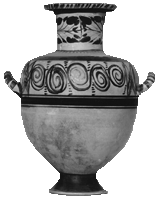Religion and
Death

The Greek
Cemetery
 Most Greek cities placed their cemeteries along the
main roads outside the city walls in order to avoid disease and
religious pollution, and perhaps even to avoid wasting valuable space
in their cities. In the case of Athens, burial inside the walls was
legally banned around 500 BC.
Most Greek cities placed their cemeteries along the
main roads outside the city walls in order to avoid disease and
religious pollution, and perhaps even to avoid wasting valuable space
in their cities. In the case of Athens, burial inside the walls was
legally banned around 500 BC.
Stone stelae with either sculpted or painted
scenes and inscribed epitaphs were the main form of grave-marker
from the 6th to the 4th centuries. Occasionally free-standing statues
served the same purpose. Stone vases like the terracotta vases
commonly associated with burial rites were also used as markers.
During the later Geometric period (ca. 760-700 BC)
the Kerameikos tombs were marked by large funerary amphoras, some as
tall as 1.5m. During the 7th century, earth mounds were constructed
over both individual graves and family plots, and large vases
continued to serve as markers.
 Hellenistic Hadra Cremation Hydria
Hellenistic Hadra Cremation Hydria
3rd century BC
61-28-1
This type of vessel was frequently used to hold the ashes of the
cremated dead, and many examples come from the rock-cut chamber tombs
and other types of burials associated with Hellenistic Alexandria. It
is also known from Crete, where it might have been made, and
elsewhere.
H. 34.8; L. 29.0; Dia. 22.5 cm. UM neg. S4-97436-7.
 Attic Red Figure Chous
Attic Red Figure Chous
ca. 450-440 BC
75-10-1
Maltese dog under a hanging bunch of grapes, perhaps illustrating a
fable. Children's burials often contain miniature vases like this
one, while adult graves rarely do. Perhaps, like rattles and dolls,
the miniatures were used as toys by the child while still living. It
is unclear whether this particular piece was intended for a child's
grave, since similar pieces also turn up in sanctuary votive deposits
and the foundation deposits of houses.
H. 10.0; Dia. 7.5 cm. Photo by Maria Daniels for the Perseus
Project. (larger
version)
 Apulian Red Figure
Panathenaic Type Amphora
Apulian Red Figure
Panathenaic Type Amphora
4th century BC
By the Ginosa Painter
On loan, Philadelphia Museum of Art
L-64-26
This South Italian vessel depicts offerings being made to the dead. A
woman approaches, holding a wreath and a cosmetic box. The man
stretches out a large offering bowl. The two converge on a small
pedimented structure representing either an elaborate grave stele or
some form of shrine to the heroized dead. The shield and helmet
inside the door suggest that the deceased was a soldier.
H. 60.5; Dia. 25.0 cm. UM neg. S4-90903. (larger
version)




The Ancient Greek World Index


![]() Most Greek cities placed their cemeteries along the
main roads outside the city walls in order to avoid disease and
religious pollution, and perhaps even to avoid wasting valuable space
in their cities. In the case of Athens, burial inside the walls was
legally banned around 500 BC.
Most Greek cities placed their cemeteries along the
main roads outside the city walls in order to avoid disease and
religious pollution, and perhaps even to avoid wasting valuable space
in their cities. In the case of Athens, burial inside the walls was
legally banned around 500 BC. Hellenistic Hadra Cremation Hydria
Hellenistic Hadra Cremation Hydria Attic Red Figure Chous
Attic Red Figure Chous Apulian Red Figure
Panathenaic Type Amphora
Apulian Red Figure
Panathenaic Type Amphora